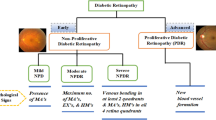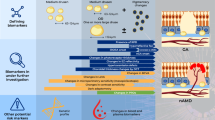Abstract
Aims
To evaluate the microvascular and neural differences of the optic nerve head (ONH) between type 2 diabetes mellitus (T2DM) subjects and controls.
Methods
This was a cross-sectional observational study. One hundred and eight eyes of 108 T2DM subjects with or without diabetic retinopathy (DR) (54 preclinical DR and 54 mild-to-moderate DR) were included. Fifty-two eyes of 52 healthy subjects were included as controls. The 4.5-mm Angio Disc scan mode and the ganglion cell complex scan mode were performed with all participants using AngioVue software 2.0 of the optical coherence tomography angiography (OCTA) device.
Results
Regarding ONH radial peripapillary capillary (RPC) density, the peripapillary region was mainly significantly reduced in the No-DR (NDR) group. Moreover, the RPC density of the peripapillary region and the inside optic disc area were significantly reduced in the non-proliferative DR (NPDR) group. When compared to the controls, significantly reduced peripapillary capillary density in six sections was observed in the NPDR group. However, reduced density was observed in only two sections in the NDR group. The NPDR group had significantly increased focal loss volume (FLV) and reduced peripapillary RNFL thickness in the inferior nasal section compared to those in the controls, but similar changes were not observed in the NDR group. A regression model identified RPCs inside the optic disc as a significant parameter in early-stage DR detection. In the NPDR group, BCVA showed a significantly negative correlation with RPCs inside the optic disc and a significantly positive correlation with FLV.
Conclusions
OCTA findings of the ONH area may provide evidence that microvascular changes occur preceding neural impairment in early-stage DR. However, further researches are still needed to support the statement. Reduced ONH perfusion inside the optic disc may be one of the crucial biomarkers in early-stage DR detection and is a possible sensitive visual acuity predictor in early-stage DR subjects. With the ONH mode, OCTA may be a more promising tool in DR screening.



Similar content being viewed by others
References
Wong TY, Cheung CM, Larsen M, Sharma S, Simo R (2016) Diabetic retinopathy. Nat Rev Dis Primers 2:16012
Stitt AW, Curtis TM, Chen M et al (2016) The progress in understanding and treatment of diabetic retinopathy. Progr Retinal Eye Res 51:156–186
Lechner J, O’Leary OE, Stitt AW (2017) The pathology associated with diabetic retinopathy. Vis Res 139:7–14
Chua J, Lim CXY, Wong TY, Sabanayagam C (2018) Diabetic retinopathy in the Asia-Pacific. Asia Pac J Ophthalmol (Phila) 7(1):3–16
Antonetti DA, Klein R, Gardner TW (2012) Diabetic retinopathy. N Engl J Med 366(13):1227–1239
Klaassen I, Van Noorden CJ, Schlingemann RO (2013) Molecular basis of the inner blood-retinal barrier and its breakdown in diabetic macular edema and other pathological conditions. Prog Retin Eye Res 34:19–48
Carpineto P, Toto L, Aloia R et al (2016) Neuroretinal alterations in the early stages of diabetic retinopathy in patients with type 2 diabetes mellitus. Eye (Lond) 30(5):673–679
Moran EP, Wang Z, Chen J, Sapieha P, Smith LE, Ma JX (2016) Neurovascular cross talk in diabetic retinopathy: pathophysiological roles and therapeutic implications. Am J Physiol Heart Circ Physiol 311(3):H738–H749
Simo R, Stitt AW, Gardner TW (2018) Neurodegeneration in diabetic retinopathy: does it really matter? Diabetologia 61(9):1902–1912
Spaide RF, Fujimoto JG, Waheed NK, Sadda SR, Staurenghi G (2018) Optical coherence tomography angiography. Prog Retin Eye Res 64:1–55
Ashraf M, Nesper PL, Jampol LM, Yu F, Fawzi AA (2018) Statistical model of optical coherence tomography angiography parameters that correlate with severity of diabetic retinopathy. Invest Ophthalmol Vis Sci 59(10):4292–4298
Kim K, Kim ES, Yu SY (2018) Optical coherence tomography angiography analysis of foveal microvascular changes and inner retinal layer thinning in patients with diabetes. Br J Ophthalmol 102(9):1226–1231
Kaizu Y, Nakao S, Sekiryu H et al (2018) Retinal flow density by optical coherence tomography angiography is useful for detection of nonperfused areas in diabetic retinopathy. Graefes Arch Clin Exp Ophthalmol 256(12):2275–2282
Alnawaiseh M, Lahme L, Müller V, Rosentreter A, Eter N (2018) Correlation of flow density, as measured using optical coherence tomography angiography, with structural and functional parameters in glaucoma patients. Graefes Arch Clin Exp Ophthalmol 256(3):589–597
Li Z, Alzogool M, Xiao J, Zhang S, Zeng P, Lan Y (2018) Optical coherence tomography angiography findings of neurovascular changes in type 2 diabetes mellitus patients without clinical diabetic retinopathy. Acta Diabetol 55(10):1075–1082
Solomon SD, Chew E, Duh EJ et al (2017) Diabetic retinopathy: a position statement by the American Diabetes Association. Diabetes Care 40(3):412–418
Whelton PK, Carey RM, Aronow WS et al (2018) 2017 ACC/AHA/AAPA/ABC/ACPM/AGS/APhA/ASH/ASPC/NMA/PCNA Guideline for the prevention, detection, evaluation, and management of high blood pressure in adults: executive summary: a report of the American College of Cardiology/American Heart Association Task Force on Clinical Practice Guidelines. Hypertension 71(6):1269–1324
Tuttle KR, Bakris GL, Bilous RW et al (2014) Diabetic kidney disease: a report from an ADA Consensus Conference. Diabetes Care 37(10):2864–2883
Carnevali A, Sacconi R, Corbelli E et al (2017) Optical coherence tomography angiography analysis of retinal vascular plexuses and choriocapillaris in patients with type 1 diabetes without diabetic retinopathy. Acta Diabetol 54(7):695–702
Simonett JM, Scarinci F, Picconi F et al (2017) Early microvascular retinal changes in optical coherence tomography angiography in patients with type 1 diabetes mellitus. Acta Ophthalmol 95(8):e751–e755
Cao D, Yang D, Yu H et al (2018) Optic nerve head perfusion changes preceding peripapillary retinal nerve fiber layer thinning in preclinical diabetic retinopathy. Clin Exp Ophthalmol. https://doi.org/10.1111/ceo.13390
Mansoori T, Sivaswamy J, Gamalapati JS, Balakrishna N (2018) Topography and correlation of radial peripapillary capillary density network with retinal nerve fibre layer thickness. Int Ophthalmol 38(3):967–974
Chan G, Balaratnasingam C, Xu J et al (2015) In vivo optical imaging of human retinal capillary networks using speckle variance optical coherence tomography with quantitative clinico-histological correlation. Microvasc Res 100:32–39
Scoles D, Gray DC, Hunter JJ et al (2009) In-vivo imaging of retinal nerve fiber layer vasculature: imaging histology comparison. BMC Ophthalmol 9:9
van Dijk HW, Verbraak FD, Kok PH et al (2012) Early neurodegeneration in the retina of type 2 diabetic patients. Invest Ophthalmol Vis Sci 53(6):2715–2719
Santos AR, Ribeiro L, Bandello F et al (2017) Functional and structural findings of neurodegeneration in early stages of diabetic retinopathy: cross-sectional analyses of baseline data of the EUROCONDOR project. Diabetes 66(9):2503–2510
Kusari J, Zhou S, Padillo E, Clarke KG, Gil DW (2007) Effect of memantine on neuroretinal function and retinal vascular changes of streptozotocin-induced diabetic rats. Invest Ophthalmol Vis Sci 48(11):5152–5159
Ziccardi L, Parisi V, Picconi F et al (2018) Early and localized retinal dysfunction in patients with type 1 diabetes mellitus studied by multifocal electroretinogram. Acta Diabetol 55(11):1191–1200
Simo R, Hernandez C, Porta M et al (2018) Effects of topically administered neuroprotective drugs in early stages of diabetic retinopathy. Results of the EUROCONDOR Clinical Trial. Diabetes. https://doi.org/10.2337/db18-0682
Araszkiewicz A, Zozulinska-Ziolkiewicz D et al (2012) Neurodegeneration of the retina in type 1 diabetic patients. Pol Arch Med Wewn 122(10):464–470
Zang P, Gao SS, Hwang TS et al (2017) Automated boundary detection of the optic disc and layer segmentation of the peripapillary retina in volumetric structural and angiographic optical coherence tomography. Biomed Opt Express 8(3):1306
Leite MT, Rao HL, Weinreb RN et al (2011) Agreement among spectral-domain optical coherence tomography instruments for assessing retinal nerve fiber layer thickness. Am J Ophthalmol 151(1):85–92.e81
Jia Y, Simonett JM, Wang J et al (2017) Wide-field OCT angiography investigation of the relationship between radial peripapillary capillary plexus density and nerve fiber layer thickness. Invest Ophthalmol Vis Sci 58(12):5188–5194
Wang Q, Chan SY, Yang JY et al (2017) Density of the macular and radial peripapillary capillary network measured by optical coherence tomography angiography. Acta Ophthalmol 95(6):e511–e512
Triolo G, Rabiolo A, Shemonski ND et al (2017) Optical coherence tomography angiography macular and peripapillary vessel perfusion density in healthy subjects, glaucoma suspects, and glaucoma patients. Invest Ophthalmol Vis Sci 58(13):5713–5722
Eladawi N, Elmogy M, Khalifa F et al (2018) Early diabetic retinopathy diagnosis based on local retinal blood vessel analysis in optical coherence tomography angiography (OCTA) images. Med Phys. https://doi.org/10.1002/mp.13142
Samara WA, Shahlaee A, Adam MK et al (2017) Quantification of diabetic macular ischemia using optical coherence tomography angiography and its relationship with visual acuity. Ophthalmology 124(2):235–244
Snodderly DM, Weinhaus RS, Choi JC (1992) Neural-vascular relationships in central retina of macaque monkeys (Macaca fascicularis). J Neurosci 12(4):1169–1193
Stone J, van Driel D, Valter K, Rees S, Provis J (2008) The locations of mitochondria in mammalian photoreceptors: relation to retinal vasculature. Brain Res 1189:58–69
Campbell JP, Zhang M, Hwang TS et al (2017) Detailed vascular anatomy of the human retina by projection-resolved optical coherence tomography angiography. Sci Rep 7:42201
Acknowledgements
The research was funded by the National Natural Science Foundation of China 81570845 and the Natural Science Foundation of Guangdong Province 2015A030313019.
Funding
National Natural Science Foundation of China 81570845; Natural Science Foundation of Guangdong Province 2015A030313019.
Author information
Authors and Affiliations
Corresponding author
Ethics declarations
Conflict of interest
The authors declare that they have no conflict of interest.
Statement of human and animal rights
All procedures were in accordance with the ethical standards of the responsible committee on human experimentation (institutional and national) and with the Helsinki Declaration of 1975, as revised in 2008 (5).
Informed consent
Informed consent was obtained from all patients for being included in the study.
Additional information
Managed By Antonio Secchi.
Publisher’s Note
Springer Nature remains neutral with regard to jurisdictional claims in published maps and institutional affiliations.
Rights and permissions
About this article
Cite this article
Li, Z., Wen, X., Zeng, P. et al. Do microvascular changes occur preceding neural impairment in early-stage diabetic retinopathy? Evidence based on the optic nerve head using optical coherence tomography angiography. Acta Diabetol 56, 531–539 (2019). https://doi.org/10.1007/s00592-019-01288-8
Received:
Accepted:
Published:
Issue Date:
DOI: https://doi.org/10.1007/s00592-019-01288-8




